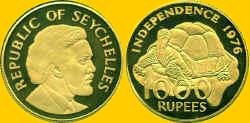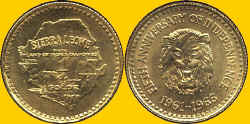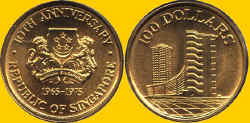This is the Worldwide Numismatics Website!
This is a modest collection of second millennium gold coins
Click the thumbnail picture to see a larger version of the picture, then use your browser BACK button to return to the original page you were viewing.
SENEGAL
Senegal's recorded history dates from the 8th century, when it was part of the empire of Ghana. As this empire waned, the Djolof kingdom arose and flourished during the 13th and 14th centuries, in the area between the Senegal River and modern-day Dakar. By the early 1500s, Portuguese traders had made contact with the coastal kingdoms, which was to last through the 16th century. They were displaced by the British, French and Dutch, who hoped to gain control of St-Louis and Gorée Island, strategic points where slaves bound for the Americas could be collected. St-Louis was finally secured by the French in 1659. By the end of the 19th century, France controlled all of Senegal, and Dakar was built as the administrative centre. Senegal sent a deputy to the French parliament as early as 1848. In the run-up to independence, Senegal joined French Sudan to form the Federation of Mali. The federation gained independence in 1960 but broke up two months later. Senegal became a republic under the presidency of Leopold Senghor.
250 Gold Francs - 1975
KM-077 - 3,98 g - 19,3 mm
Edge - Reeded
Mintage
- 1.000
This NCLT "coin" was minted by the Pobjoy Mint to commemorate the 25th anniversary of the Eurafrique Programme. The obverse has a facing bust of the President with his name LEOPOLD SEDAR SENGHOR (b1906-d2001) around the top, EURAFRIQUE to the right, and the date 1975 below. The reverse has the nation's arms with the name REPUBLIQUE DE SENEGAL around the top and the denomination 259 FRANCS OR at the bottom.
SERBIA
Serbia can be viewed as a collection of disparate ethnic groups who are largely hostile to one another, following a long history of conflict. Though Serbia had been independent at various points in time, the Ottoman conquest in 1389 kept Serbia submissive until 1878, when it reestablished its independence. The Balkans engaged in a series of wars, the last of which led directly to the outbreak of World War I. After the war, Yugoslavia was cobbled together from many small nations and peoples: Serbs, Slovenes, Croats, Bulgarians, Albanians, Macedonians, and more. Since 1990, Yugoslavia has disintegrated as several states seceded. Finally in mid 2006, Montenegro declared and its independence. Serbia is now a revived state with its historic name.
20 Dinara - 1882-V
KM-017 - 6,45 g
Mintage - 0,300M
This coin was minted at the Venice Italy mint for the Kingdom of Serbia. The obverse features a bareheaded bust of King Milan Obrenovic I (b1854-d1901) around which circles the Serbian legend MILAN I KING OF SERBIA with the designer's name under the bust. Milan was able to gain Serbian independence from Ottoman Turkey in 1878. The reverse has a wreathed crown surrounding the denomination and the date. Below the wreathe is the mintmark V.
SEYCHELLES
Although there is much speculation about early Persian and Arab seafarers visiting the islands hundreds of years before Christ was born, no documentary evidence exists. However in the ninth century, the Seychelles appear for the first time on Arab charts and are referred to as the "Tall Islands" following an expedition to the Maldives. A few hundred years later the Seychelles appear on more Arabic maps and are referred to as "Zarin" ("the Sisters"). Several historical books record that Vasco da Gama discovered the Seychelles. However that is not strictly true as he only discovered part of them, the group of islands known as the Amirantes islands in 1502. A fellow countryman, João de Nova, discovered the Farquhar group the year before but rarely makes it into the history books. By 1903, Seychelles had become a crown colony. The British Governor, Mr. Sweet-Escott, commemorated the event by erecting a clock tower in the center of Victoria, which was modeled on the clock standing outside Victoria railway station in London. In 1975 the Seychelles Democratic Party (SDP) and the Seychelles People United Front (SPUF) formed a coalition government. In 1976 on June 29th the Seychelles became an independent republic. James Mancham became the first President whilst Albert René was elected as Prime Minister. On the 5th June 1977 whilst James Mancham was at a Commonwealth Conference in London, Prime Minister Albert René overthrew the government with a bloodless political coup and was installed as the new President.
1.000 Rupees - 1976
KM-029 - 15,98 g - 28 mm
Edge
-
Mintage - 5.000
This NCLT "coin" was minted to commemorate the declaration of independence. The obverse has a bust of President James Richard Mancham (b1939-d) and the country's name in English REPUBLIC OF SEYCHELLES. The reverse has a tortoise with INDEPENDENCE 1976 above and the denomination 1000 RUPEES below.
SIERRA LEONE
The Sierra Leone Company, formed in 1791, administered the settlement until 1808, when it became a crown colony. Britain set up a protectorate over the hinterland of Freetown in 1896. The first elections for the legislative council were held under the constitution of 1924. The ministerial system was introduced in 1953, and Sir Milton Margai, a former physician and leader of the Sierra Leone People’s Party (SLPP), was appointed chief minister in 1954 and prime minister in 1960. Archaeological findings show that Sierra Leone has been inhabited for thousands of years. Traditional historiography has customarily presented it as peopled by successive waves of invaders; but the language pattern suggests that the coastal Bulom (Sherbro), Temne, and Limba have been in continuous settled occupation for a long time, with subsequent sporadic immigration from inland by Mande-speaking peoples, including Vai, Loko, and Mende. They organized themselves in small political units—independent kingdoms or chiefdoms—whose rulers' powers were checked by councils. Secret societies, notably the Poro society, also exercised political power as well as instructing initiates in the customs of the country. Sierra Leone became an independent nation on 27April 1961.
¼ Golde - 1966
KM-022 - 13,64 g - 24,3 g
Edge - Reeded
Mintage
- 5.000
This coin was issued to commemorate the fifth anniversary of independence. The obverse features a mapo of the country with the superimposed legend SIERRA LEONE - LAND OF IRON & DIAMONDS -¼ GOLDE. The reverse has the head of a lion surrounded by the legend FIFTH ANNIVERSARY OF INDEPENDENCE - 1961-1966.
SINGAPORE
According to Malay legend, a Sumatran prince encountered a lion - considered a good omen - on Temasek, prompting him to found Singapura, or Lion City. It mattered little that lions had never inhabited Singapore (more likely the prince had seen a tiger); what did matter was the establishment of the region as a minor trading post for the powerful Sumatran Srivijaya empire and as a subsequent vassal state of the Javanese Majapahit empire in the mid-13th century. Singapore might have remained a quiet backwater if not for Sir Stamford Raffles' intervention in 1819. The British had first established a presence in the Straits of Malacca (now called Melaka) in the 18th century when the East India Company set out to secure and protect its line of trade from China to the colonies in India. Fearing another resurgence of expansionism in the Dutch - which had been the dominant European trading power in the region for nearly 200 years - Raffles argued for an increased British presence, which he was promptly given. Under his tutelage, Singapore's forlorn reputation as a fetid, disease-ridden colony was soon forgotten. Migrants attracted by a tariff-free port poured in by the thousands, and a flourishing colony with a military and naval base was established. Singapore's inexorable growth continued into the 20th century. However, the outbreak of WWII brutally exposed the fallacy of British might: they suffered the ignominy of defeat when Japan invaded the colony in 1941. The British were, however, welcomed back after Japan's surrender in 1945, but their right to rule was no longer assured. By the 1950s, burgeoning nationalism had led to the formation of a number of political parties as Singapore moved slowly towards self-government. The People's Action Party, with the Cambridge-educated Lee Kuan Yew as leader, was elected in 1959. Lee became prime minister, a position he was to hold for the next 31 years. In 1963, Singapore formed a union with Malaya (now Malaysia) but by 1965, the nascent federation was in tatters. Singapore became independent soon after.
100 Dollars - 1975
KM-012
- 6,91 g
Edge - Reeded
Mintage - 0,100M
This NCLT "coin" was struck to commemorate the 10th anniversary of independence. The obverse has the nation's arms with the legend - 10TH ANNIVERSARY - REPUBLIC OF SINGAPORE with the dates 1965-1975 just below the arms. The reverse has high rise flats as a symbol of the republic's housing programme with the denomination 100 DOLLARS at the top.
If you would like to see additional gold coins, please click here - Page 29
If you want to return to the home page, please click here - Home


